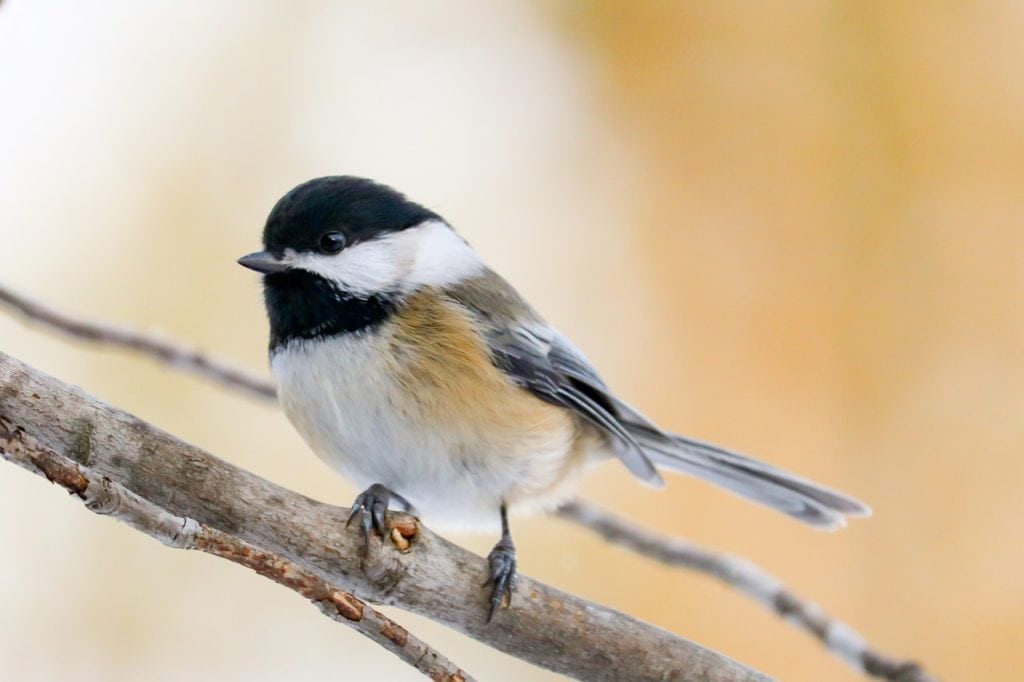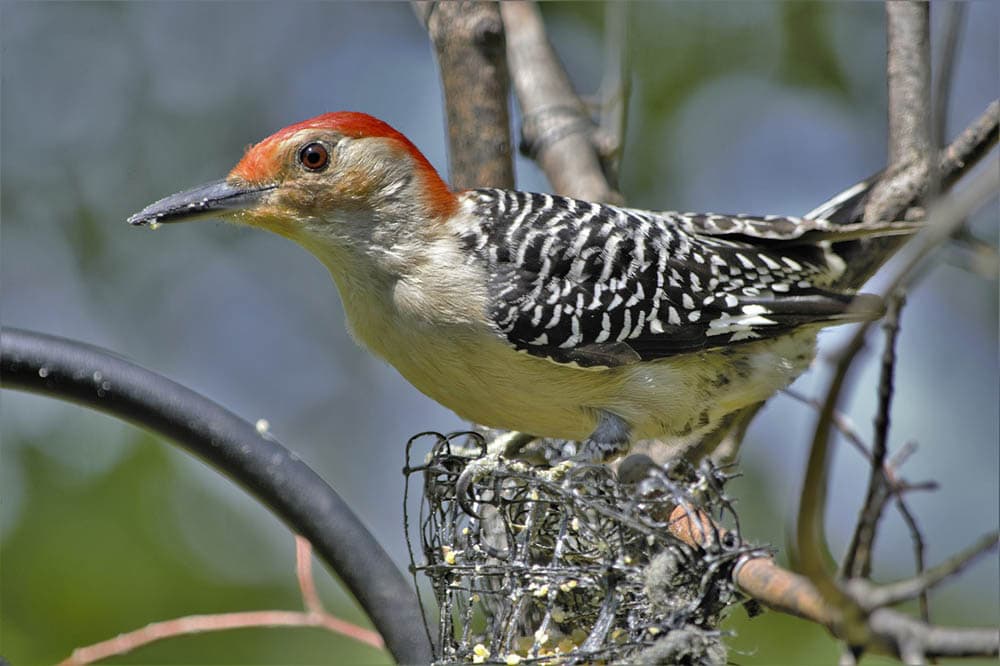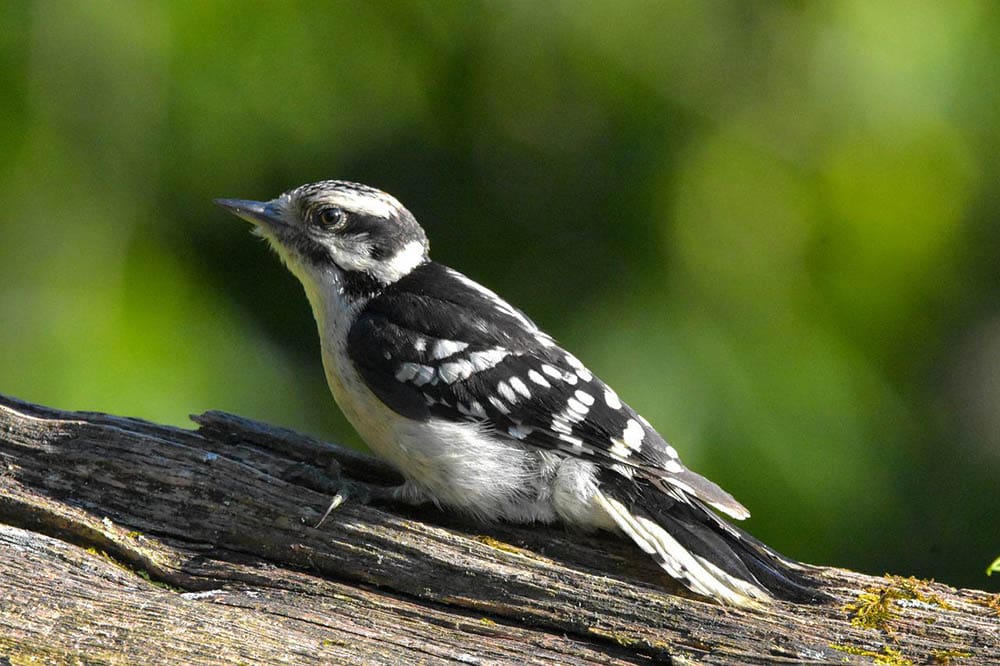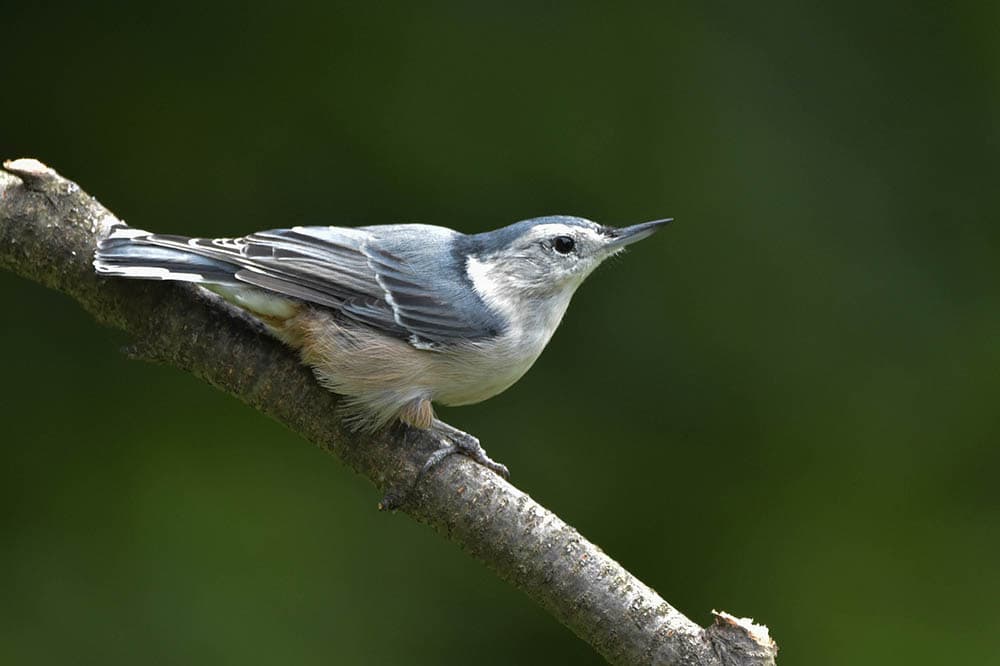19 Common Backyard Birds in Missouri (with Pictures)
Last Updated on

Watching birds in the state of Missouri can be a very fulfilling hobby. Hundreds of species reside in the state and if you are in need of a little afternoon enjoyment, consider installing a bird feeder to become familiar with some of them. The warm humid weather allows for fun bird watching during most of the year. And if you want to keep the birds coming back to your yard, just be sure to provide them with a few things:
- Clean water for bathing and drinking
- Quality bird seeds that are easily accessible
- Places to nest such as trees, shrubs, or pre-made nest boxes
If you have all of these elements, you’re guaranteed to see birds flocking to your yard on a daily basis. Let’s take a look at some of the most common bird species found in Missouri.

The 19 Most Common Backyard Birds in Missouri
1. Black-Capped Chickadee

| Typical Diet: | Dried fruit, various insects, seeds |
| Appearance: | Short, stocky with a white-grayish black head with white cheeks; large gray belly |
| Daily Habitat: | Forests and deciduous areas |
The Black-capped Chickadee is one of the most common Missouri songbirds and is especially eye-catching. These birds have black and white wings with a black hooded head, making them stand out easily during the day. They are relatively small and have a stocky build. You can find them often perched on small twigs munching on insects or seeds. They fly in large flocks and may be seen with other bird species as well.
2. Song Sparrow

| Typical Diet: | Insects, plants, grain, fruit |
| Appearance: | Brown with black spots, short and slim |
| Daily Habitat: | Deciduous, wet, or open areas |
The Song Sparrow is one of the most common brown birds in Missouri. It has brown spotted feathers and is known for its spectacular song which is used to attract mates during the spring and fall months. They are seen all throughout the year but tend to migrate to the southern states in the winter. You’ll usually find them in wet open areas perched on low-hanging limbs or shrubs. They have a varied diet and love to snack on plants, insects, cherries, grains, and sunflower seeds.
3. Mourning Dove

| Typical Diet: | Seeds, grasses, peanuts, and herbs |
| Appearance: | Large bird with grayish Brown feathers and black spots on the wings |
| Daily Habitat: | Farmlands, woods, forest preserves |
Mourning Doves are fairly common in most states, especially those in the Midwest. They tend to prefer moderate climates and you can find them often perched on phone lines and traffic signs. They’re slightly larger than American Robins and Blue Jays and have brown or tan bodies with small spots on their wings. These birds love sunflower seeds and are commonly seen around wooded areas and localfarmlands.
4. Pileated Woodpecker

| Typical Diet: | Local insects, fruit, nuts |
| Appearance: | Medium-sized, black feathers with red hood |
| Daily Habitat: | Open areas, deciduous lands |
Pileated Woodpeckers are the most common woodpecker found in North America. They have mostly black feathers with stripes of white running along their necks and head. Their striking red hood makes them stand out amongst other local varieties. They enjoy munching on termites, dead wood, nuts, berries, and ants. Their loud shrill-like call is noticeable and useful for warding off predators.
5. Chipping Sparrow

| Typical Diet: | Scratch feed, grains, and nuts |
| Appearance: | Slim and long with gray and brown feathers |
| Daily Habitat: | Open ground and moderate climates |
Chipping Sparrows have long tails and a slender build. Their feathers are brown and grayish and covered with a black streak on their back. One thing that makes them stand out the most is their rust-colored heads and amazing black-rimmed eyes. These birds are commonly seen in Midwestern states such as Missouri, though they tend to fly south for the winter to southern states such as Florida and Texas. You may find them in your backyard munchingon nuts, seeds, grain, and any leftovers that you throw out.
6. Red-Bellied Woodpecker

| Typical Diet: | Seeds, nuts, ants, grasshoppers, caterpillars, and earthworms |
| Appearance: | Large with striped black and white backs, white bellies, and red hoods |
| Daily Habitat: | Wood lawns and open plains |
The Red-bellied Woodpecker is sure to catch your attention with its striking tufted hood and beautiful black and white striped back. They have white bellies and are a bit larger than most backyard birds. They typically feast on seeds, nuts, and small insects and you may find them lurking around if you have tall trees in your yard.
7. Dark-Eyed Junco

| Typical Diet: | Seeds, various nuts,small insects |
| Appearance: | Short with a stocky build and grayish feathers; white grayish belly |
| Daily Habitat: | Forests and mountainous areas |
You may often see these Juncos hanging around your backyard during the colder months of the year, as they tend to migrate to the state during the cold seasons. They’re native to local areas with mountains and tall forests, as it’s easy for them to hide from predators.
Juncos have small stocky bodies and round hooded heads, which makes them easy to spot during the day. These birds are relatively easy to attract. All you need is a tray feeder and a nice supply of seeds or grains.
8. Blue Jay

| Typical Diet: | Nuts, seeds, small insects including ants, grasshoppers, spiders, small frogs and rodents |
| Appearance: | Medium build with light blue feathers; Blue tufted hoods with black-lined necks |
| Daily Habitat: | Open areas, small shrubs |
The Blue Jay is another bird commonly associated with the state of Missouri. These medium-sized birds are fairly similar to the Northern Cardinal in their build and feathers, with the exception of having blue wings and white bellies. They have a blue hood and necks lined with black feathers. They’re known for their long legs and tails, and you will kindly see them perched on short shrubs eating fallen nuts and seeds.
9. American Robin

| Typical Diet: | Earthworms, fruit, wild berries, insects including ants spiders and grasshoppers |
| Appearance: | Medium size, tan belly with dark gray head and body |
| Daily Habitat: | Woodlands, suburban backyards, grasslands within shrubs, parts, suburban backyards |
There’s one bird that you’ll see all year round it’s the American Robin. It’s very easy to attract these birds to your backyard. All you need is a feeder with seeds or fruit and they’re likely to be frolicking in the area within a few hours. They have round plump bodies, similar to Blue Jays, and a deep rust orangish-colored belly. They’re common in backyards as well as open areas such as parks and local woodlands.
10. American Goldfinch

| Typical Diet: | Weed seeds, grass, thistle |
| Appearance: | Small and round with bright yellow bodies, black hoods |
| Daily Habitat: | Open plains, backyards, and woodlands |
The American Goldfinch is another species common to Missouri. They have small stocky bodies and bright yellow feathers which makes them easy to see during the day. They’re slightly larger than Hummingbirds and have beautiful black hoods with orange beaks.
Their typical diet includes thistle, grass, and various weed seeds. If you want to attract them, simply set out a small tube feeder.Be sure to check for them during the early morning hours when they are out searching for breakfast.
11. Tufted Titmouse

| Typical Diet: | Sunflower, peanuts, suet, and other seeds |
| Appearance: | Short and stocky with round bellies; White bellies with gray tufted hood |
| Daily Habitat: | Low shrubs or tall trees, deciduous areas |
The Tufted Titmouse are short birds with round white bellies, though they are fairly large overall. They have long tails and grayish hoods and wings. They are known to feed on insects including grasshoppers, ants, spiders, and will also munch on sunflower seeds (amongst other seeds), peanuts, suet, and grains. To attract them to your backyard, add a nest box or two, and be sure to install a guard to prevent predators from raiding their eggs.
12. Northern Cardinal

| Typical Diet: | Seeds, grains, ants, beetles, caterpillars, flies, and other insects. |
| Appearance: | Medium build; all red feathers with black-lined eyes |
| Daily Habitat: | Wooded areas with tall trees, shrubs, and open plains |
The Northern Cardinal is easily identifiable by its all-red body and black-lined eyes. It’s one of the most common red birds in Missouri. Highly popularized by St. Louis’ own Cardinals baseball team, this beautiful bird can be seen on a regular basis in open or wooded areas. It is a medium-size bird and has brilliant red feathers covering it from head to toe. It’s a relatively tall bird compared to others and is known to munch on flower seeds, insects, and grains.
13. Downy Woodpecker

| Typical Diet: | Seeds, beetle larvae, small insects, and wild berries |
| Appearance: | Short and round with black and white striped feathers; red spot on crests |
| Daily Habitat: | Small streams, wilderness suburban yards, and deciduous areas |
The Downy Woodpecker is a popular woodpecker species found in Missouri. They have large heads and short black tails. They’re also known for their distinctive feather pattern and the noticeable red spot on their crest. Overall, they have spotted black and white wings with white grayish bellies. They are short in stature and relatively stocky. You can easily attract these birds with dead insects, fruit, and various seeds.
14. Carolina Wren

| Typical Diet: | Grasshoppers, ants, snails, suet, and seeds |
| Appearance: | Stocky and short with brown feathers and tannish-white belly |
| Daily Habitat: | Swamps, bushy thickets, backyards, wooded areas |
Carolina Wrens are fairly common in Missouri backyards and other open areas. You’ll usually find these birds hanging around the state the entire year. Overall, they have a relatively short and stocky build, with brown feathers and light tan or white bellies. They look really similar to the American Robin, and you may have trouble distinguishing the two. You may find them around your front or back yard munching on small insects such as spiders, snails, and ants.
15. Northern Flicker

| Typical Diet: | Ants, beetles, and other insects, as well as seeds and nuts |
| Appearance: | Large, round; Spotted grayish feathers with red spot on nape of neck |
| Daily Habitat: | Forest Preserves, wooded areas, on tall trees |
The Northern Flicker belongs to the woodpecker family and is distinctively colored with spotted black and grey feathers, with a red spot on the side of its beak. It has a large round build with a long beak and dark brown tail. These birds are also known for the beautiful yellow feathers beneath their wings, and you can often hear them in your front or back yard drilling into tree bark looking for ants and other small insects to snack on.
16. White-Breasted Nuthatch

| Typical Diet: | Insects, nuts, and various seeds |
| Appearance: | Small, slim with round white belly and a large head; Blue-grayish wings and head |
| Daily Habitat: | Deciduous areas, open plains, parks, on small shrubs |
White-breasted Nuthatches have beautiful blue and white feathers with a wide belly. They’ll also appear with grayish hues that may turn blue during the warmer months. They have a relatively small build and slender bodies which allows them to nest and feed sitting on small fan branches. You’ll find them foraging in your backyard for nuts, seeds, and small insects.
17. Eastern Bluebird

| Typical Diet: | Fruit, nuts, mealworms, berries, and insects |
| Appearance: | Slim, round and small with blue wings and white-brownish bellies |
| Daily Habitat: | Open areas, around small shrubs |
Eastern Bluebirds are known in the area for their distinctive colors. Their wings and heads are light blue while their necks and bellies have an ombre appearance of white and light brown. They’re pretty easy to identify and are usually perched on home benches, short shrubs, or small trees. They have small round bodies though they are relatively slim overall. Their diet mainly consists of wild fruit, local insects, mealworms, and berries.
18. White-Throated Sparrow

| Typical Diet: | Mostly seeds, weeds, caterpillars, flies, and spiders |
| Appearance: | Short and slim with brown above and gray-striped head with yellow spot |
| Daily Habitat: | Deciduous forest and Woodland areas, open areas with short shrubs |
White-throated Sparrows are commonly seen perched on phone lines or in backyards. They are medium-sized birds with small round heads and barely visible necks. These sparrows have slim, long bodies and a distinctive head pattern that is striped with black and white feathers and a small yellow spot. They are fairly long given their height and you can find them hanging out locally all throughout the year. These sparrows are known to munch on wild berries, seeds, and small insects.
19. Common Starling

| Typical Diet: | Small insects mostly, but will eat seeds |
| Appearance: | Short round with iridescent feathers of purple, blue and black |
| Daily Habitat: | Open fields, Suburban backyards, and deciduous areas |
Common Starlings (aka “European Starling”) is one of the most uniquely colored birds that you’ll see in the Missouri area. It has a short and stocky build with gorgeous iridescent feathers which may appear blue, black, and shades of purple depending on your view.
These beautiful birds tend to change colors throughout the year and look fairly similar to the American Crow. If you want to attract them to your yard, be sure to lay out a tray feeder, as their legs are too weak to climb onto tube feeders. They have short beaks and small oval heads. They can be found on nearby branches and shrubs grubbing on insects such as snails, caterpillars, grasshoppers, spiders, and earthworms.

Conclusion
As you can see, the state of Missouri is home to a variety of backyard bird species. If you’re looking to start bird watching as a hobby, try installing a tray or tube feeder in your backyard and filling it with seeds or suet. You’re likely to see a number of different species popping up fairly quickly all throughout the year.
See Also: 15 Common Types of Sparrows in Missouri (With Pictures)
Featured Image Credit: GeorgiaLens, Pixabay
Table of Contents
- The 19 Most Common Backyard Birds in Missouri
- 1. Black-Capped Chickadee
- 2. Song Sparrow
- 3. Mourning Dove
- 4. Pileated Woodpecker
- 5. Chipping Sparrow
- 6. Red-Bellied Woodpecker
- 7. Dark-Eyed Junco
- 8. Blue Jay
- 9. American Robin
- 10. American Goldfinch
- 11. Tufted Titmouse
- 12. Northern Cardinal
- 13. Downy Woodpecker
- 14. Carolina Wren
- 15. Northern Flicker
- 16. White-Breasted Nuthatch
- 17. Eastern Bluebird
- 18. White-Throated Sparrow
- 19. Common Starling
- Conclusion
About the Author Robert Sparks
Robert’s obsession with all things optical started early in life, when his optician father would bring home prototypes for Robert to play with. Nowadays, Robert is dedicated to helping others find the right optics for their needs. His hobbies include astronomy, astrophysics, and model building. Originally from Newark, NJ, he resides in Santa Fe, New Mexico, where the nighttime skies are filled with glittering stars.
Related Articles:
Monocular vs Telescope: Differences Explained (With Pictures)
10 Types of Hummingbirds in Arkansas (With Pictures)
8 Types of Hummingbirds in Nebraska (With Pictures)
5 Types of Hummingbirds in Idaho (With Pictures)
3 Types of Hummingbirds in Mississippi (With Pictures)
8 Types of Hummingbirds in Kansas (With Pictures)
5 Types of Hummingbirds in West Virginia (With Pictures)
5 Types of Hummingbirds in Ohio (With Pictures)
